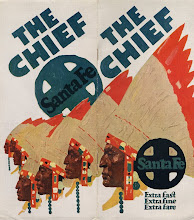This fall semester I am teaching a history course at Florida International University in the evenings entitled, America & Movies: the Great Depression and New Deal Era in Film and History. Forty-five students are enrolled in the class which has been designed to get them to view Hollywood films with a more critical eye and to use other visual and non-literary primary source materials in their research projects. Half a dozen students have opted to work on a special curatorial project using the Wolfsonian's outstanding collection of New Deal era artifacts. The exibits they design will be made available via a link on this blog sometime in late November. Here is a teaser of some of the objects in our collection and the ideas and messages the students have taken from them.
LIBRARY OBJECT(S) OF THE WEEK

Within the first hundred days of taking the oath of office, President Franklin Delano Roosevelt attempt to "jump-start" the moribund American economy back to life through the passage of the first of his "New Deal" programs: the National Industrial Recovery Act (1933) and the National Recovery Administration, (or NRA). The Roosevelt administration consciously promoted this program with patriotic symbols and colors. Charles T. Coiner designed the NRA's emblem, a "blue eagle." This "thunderbird" carried in its talons a cogwheel as the symbol of industry and lightning bolts representing the electrical power that would be generated through other New Deal programs like the REA (Rural Electrification Administration), and the TVA (Tennessee Valley Authority) tasked with building large hydroelectric dams. Although membership and compliance with NRA regulations was voluntary, businesses who refused to display the eagle were often subject to boycotts and in 1935 the conservative judges on the Supreme Court ruled the NRA unconstitutional.


But even before the NRA was challenged and defeated on constitutional grounds, the Left also criticized the program as a "businessman's dole" and a woefully inadequate and inappropriate response to the Great Depression. The Socialist Labor Party chose to attack the NRA in a pamphlet that lampooned its symbol by placing an elitist top hat on its head, and by having workers and industry helplessly suspended in its talons. The text also spoofs the NRA’s lightening bolt imagery, warning that "though an electric current may induce spasms resembling life even in a corpse–so it is utterly impossible to restore life to the corpse of capitalism.” The Communist Party of the United States was equally dismissive of the NRA's efforts on behalf of the working class, and on the cover of the October 1933 issue of the Labor Defender, they superimposed a swastika over, and filled in the hollow outline of the "thunderbird" emblem with sepia-toned photomontages of striking workers being beaten by police and soldiers.
For more information on the Wolfsonian Library's collection of New Deal materials, see:
http://www.librarydisplays.wolfsonian.org/WPA/wpa.htm
http://www.librarydisplays.wolfsonian.org/New%20Deal/NewDeal.htm
http://www.librarydisplays.wolfsonian.org/Great%20Depression/GD%20home.htm




No comments:
Post a Comment